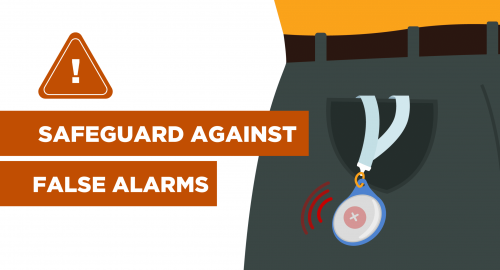Listen to this blog
4 minutes
In recent months, there have been a number of active shooter panic alert false alarms at schools in the United States. In Florida, there have been several false alarms indicating active shooters, leading to school lockdowns and disruptions to the school day. In Georgia, a new safety feature that sends automated text messages to parents and students in the event of a lockdown has some parents concerned about the potential for false alarms and the trauma they can elicit.
The problem?
The security badges are the size of a credit card, and each has a button. If the button is pressed too many times—by, for instance, being leaned on in a pocket or purse—the school goes into lockdown.
Some badge panic solutions have been reported in the media to have 10-20% of their alerts accidentally activated as badges placed in pockets or purses become unintentionally activated.
The cost of false alarms
These false alarms cause a substantial disruption to the school day, but the repercussions reach far beyond a disrupted day. They also can have a significant impact on the mental health of students, parents, and teachers. And, because of the exorbitant cost of implementing a badge-based system, school communities may begin to question whether the cost to their children’s mental health is worth it.
A closer look: False alerts and their impact on mental health
The fear of being caught in an active shooter situation can be very real and debilitating—and the experience of a false alert may cause the community to question the school safety plan’s effectiveness.
False alarms can be a traumatic and frightening experience for students, parents, teachers, and staff who are directly impacted by the incident or who may have loved ones involved in the school. The fear and stress associated with a false alarm can result in several consequences for your school community, including:
- Anxiety, depression, and post-traumatic stress disorder (PTSD) during the event,
- Feelings related to a loss of safety and security, and
- Longer-term consequences in which the fear and uncertainty of the incident linger, leading to ongoing anxiety and stress in the weeks and months following the event.
In the aftermath of a false alarm, it’s important for schools to prioritize the mental health and well-being of students and staff. Be sure to offer counseling and support services to those directly impacted by the incident and provide resources to help students and staff cope with the trauma’s aftermath.
Cultivating a school culture that supports the mental health of students and staff means choosing the right technology for managing their safety. Let’s take a closer look at the impact of false alarms like the ones above—and at what emergency alerting features best insulate your school community against the stress and trauma of a false alarm.
A closer look: False alerts and their financial burden
The financial cost of a false alert can be substantial. The police and first responder response and the loss of productivity from staff and students all have a financial cost to the district and community. But it is the significant cost of implementing a proprietary hardware-based panic alert system that is prone to false alerts that can lead to questions in the community.
For example, the media reports it will cost a Louisiana school district $2.3 million to implement a badge-based alerting system. Despite being marketed as a one-time cost, most IT professionals will tell you any hardware solution will need to be maintained and updated as it becomes quickly obsolete.
Raptor’s fully integrated systems cost up to 10 times less upfront, and the ongoing maintenance costs are 50-75% lower than a single-function hardware-based solution that is limited to a single type of emergency response.
Additionally, software-based solutions allow for updates to the system without requiring the expense of replacing an entire system—which makes app-based solutions far more financially sustainable.
Choosing the right tool for alerting
School safety and security present complex and ever-evolving challenges—and preventing false alarms adds to those challenges.
Hardware-based solutions with badges and receivers create opportunities for false alarms. Not only can they be accidentally activated by staff, but they can also be activated (intentionally or otherwise) by non-authorized people such as students.
App-based solutions like Raptor Alert, in contrast, provide:
- A slide button within the app to trigger alerts—which reduces the chances of accidental activation.
- Second level protection against Raptor Alert misuse with Face ID—so a student can’t pick up the phone and trigger the alert like they could with a badge.
Protect your school with Raptor
When it comes to choosing the right tool for emergency alerting, it is essential to consider the limitations of hardware-based solutions, which can be prone to false activations and require ongoing maintenance.
To learn more about Raptor Alert and how it can effectively safeguard your school community, schedule a demo.
Related Resources
Guide to K-12 Emergency Management
Proven Strategies to Protect Your School
Listen to this blog
4 minutes








